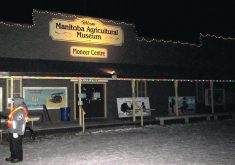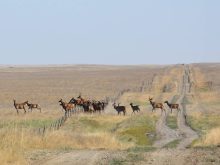The next generation is introduced to the puffing dragons that once played a major role in western Canadian agriculture
Glacier FarmMedia – Max, age 8, (almost 9, he emphasized) cranked the steering wheel of the black, green and red Case steam engine and leaned back over the metal-cleated wheel that revolved slowly over the turf in Austin, Man.
Andy MacMillan stood at the throttle, supervising the overall-clad, soot-streaked youngster.
“Does he have a licence for this thing?” I asked Andy from my perch between the tenders.
Read Also

New program aims to support plant-based exports to Asia
Understanding the preferences of consumers in Taiwan and how they differ from Indonesia or Malaysia isn’t easy for a small company in Saskatchewan.
No, but he knows what he’s doing, I was told. He’d practically been born on one of these things.
Max’s mom, Danielle Farquhar, confirmed the boy had been aboard a steam engine in utero. She’d been at the Thresherman’s Reunion in Austin, pregnant while running a steam engine. Max arrived a week later.

“Then he was what, six or seven days old when he was on the back of one,” Danielle said.
“It’s kind of fun.”
Danielle, husband Colin Farquhar, Max and Wesley, 5, had driven from Chilliwack, B.C., to camp on the grounds of the Manitoba Agricultural Museum for the annual Manitoba Thresherman’s Reunion at the end of July.
I found them on the infield of the rodeo grounds, where they were making grilled cheese sandwiches with camp irons, using the fire inside the box of Lynn Tutthill’s 1912 Gaar-Scott steam traction engine.
It was the first day of the Thresherman’s Reunion. There were 10 or 12 traction engines standing, boilers fired, waiting for the parade in the early afternoon. The Farquhars were not the only family with small children tending a steamer.
My own first exposures to steam traction engines involved my local Pioneer Days parade, in which the enormous, puffing engine and its toot-toot train whistle played a prominent role. It had been driven by those who I, a child, viewed as old-timers.
Thanks to events such as Steam School and the influence of parents or mentors, young people now have a conspicuous place in Manitoba’s steam tractor community.

Steam engines arrived in Manitoba in the late 1800s. Likely too big and expensive for all but the largest of farms, traction engines were frequently owned by custom threshing or plowing outfits until gas or diesel-powered tractors took over.
Today, steamers in Manitoba are mostly owned by private collectors. A few have been donated to museums. The provincial government has the final say in which steamers can be driven in public and who can drive them.
Plenty of things can go wrong. Say “Medina” to a steam engine enthusiast and they’ll know exactly what you mean.
In July 2001, a traction engine exploded on the state fairgrounds at Medina, Ohio. It killed the owner, his son and two onlookers and injured many more with flying shrapnel and super-heated steam. Some sources say hot oil, but this is unlikely, said Gerald Dueck, a long-time engineer and Steam School instructor.

Various engineers told me the 1918 Case was a junker that should never have been driven, but they also agreed operator error was to blame.
Drivers closely monitor the steam pressure and water levels in their engines to keep pressure from climbing too high or from boiling dry. Introducing water from the reservoir below the floor of the engine is one way to reduce steam pressure.
That day in Medina, the driver let his water get too low and the boiler too hot. Perhaps realizing his mistake, he opened the valve and introduced cold water. When it hit the red-hot metal, it instantly turned to steam. The boiler exploded, ripping the engine in half.
Although steam engines were inspected before the explosion, authorities cracked down further after that.
“It was a very sharp change,” said Colin Farquhar, who was running engines in British Columbia at the time.
“The inspection requirements became a lot more strict.… I had to get blueprints out of England from the factory that built it so that we could test the boiler (to determine the change in thickness).”
The Manitoba government also cracked down on hobby engineers, according to anecdotal reports. Today, the province’s labour and immigration department oversees the inspection of “historical steam traction boilers,” as they’re officially designated.

Bruce Eberling, vice-president of the Steam Association of Manitoba, said these historical boilers follow the same rules as commercial boilers. They’re inspected yearly, with a pressure test every three years and an ultrasound inspection every five years to determine the thickness of the boiler.
If the engine doesn’t pass inspection, it must be fixed. If the boiler is too thin to safely hold steam, it may be condemned or the owner may replace it with a reproduction.
“These things take a lot of looking after to be safe,” Eberling said.
“It kills the hobby a little bit because things become so expensive that you can’t afford to do them anymore.”
“Every repair basically starts at $3,000 and goes up,” Dueck said.
The Steam Association of Manitoba formed in the mid-2000s as a liaison between the province and engineers to provide quality assurance and to “police operators that needed a little bit of police — cowboys,” Dueck said.
Members formed their own quality assurance program and proved to provincial inspectors that old-fashioned boiler construction, such as the lap-seam — a practice that overlaps sheets of metal and rivets them together — could be safe.

The association also launched its own Steam School, which is accredited with the National Board Inspection Code, an international standard for pressure equipment.
Steam School is a weekend training event for steam engine operators who want to get their operator’s licence from the province. This licence requires operators to pass a written test, acquire 120 hours of operation experience and pass a driving test.
Operators must prove they can, among other skills, safely park on a slope and stop the machine in time to avoid an object thrown between the wheels. Despite their bulk, the machines can stop quickly when thrown into reverse, no doubt helped by a top speed of around two m.p.h.
I arrived at Steam School, held in Austin in early August, as class was under way. Dueck, a mathematics and computer science professor, stood by a steam engine on which the side of the boiler had been cut away to reveal the inner works.
Thirteen students, most clad in overalls, and several Steam School staff, stood in a semi-circle as he described the construction of the boiler. They then traipsed into the dim, plywood cafeteria where a projector had been set up.

The class included teen boys, a few younger men and women, and one retirement-age man who told me he’d always wanted to operate a steam engine. Some came from Saskatchewan, British Columbia and North Dakota.
Some had never driven a steam engine, but after lunch, when students were divided up for hands-on practice, about half filtered into the group for experienced steamers.
Among these was Annika, 17, who I’d met previously at the Pembina Threshermen’s Museum near Morden. She was operating a steam engine alongside her dad, Bill, as she’d done since age 14, and was nearing qualification for her steam ticket or licence.
“It just seemed like a unique thing to do,” she said.
“A little dangerous, but a little fun.”
Annika’s entry into the steam world was similar to many I heard about as I spoke with steam enthusiasts across Manitoba. They inherited the interest, so to speak.
Bob Giesbrecht’s dad was one of a group of Steinbach-area men who bought a 1912 Case engine to restore in 1971.
“They actually sent me inside the firebox, and I worked inside there,” Giesbrecht recalled.
He was 16 at the time, and today isn’t sure what he was tasked with back then — possibly cleaning around the flues with an angle grinder.
He’s co-owner of the steamer now. Giesbrecht talked to me after he and a group of like-minded volunteers finished their first steam-powered threshing demonstration of the day, which was part of Pioneer Days celebrations at the Mennonite Heritage Village.
Andy MacMillan figured he was four or five years old when he started steaming. His family spent their summers driving from steam show to steam show in places like Park River, N.D., and Rollag, Minnesota, with their miniature steamer.
“We had a 1981 Dodge crew cab, and it was a one-ton,” he said.
“Our half-scale would fit just in the back. We’d have to open the sliding window in the back so the smoke box door handle would fit through.”
It was trips like these, or through volunteering at museums, that people like Andy and young Max made friends — sometimes intergenerational friends — with folks who had the same passion for historic farm machinery.
At the end of the day, however, the draw is clear. Steam engines are big, cool machines. They puff, hiss and rattle and — as I found when Eberling, my friend Steph and I took a spin around the Pembina Threshermen’s Museum — are a beast to steer.
“As a kid, coming here (to the Mennonite Heritage Village), seeing them, and just reading about and seeing pictures, I thought that steam engines were just cool,” said Reg Janzen.
Added Dueck: “Everything’s on the outside. You can see it all move. There’s no mysteries.”
He quickly retracted this.
“There’s some really interesting gadgets on a steam engine that you have to take apart in order to see how they work. They’re a big cool machine, and it’s completely different.”


















